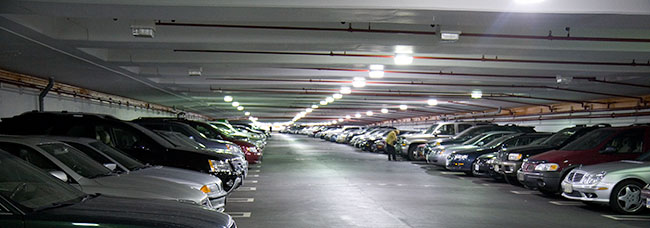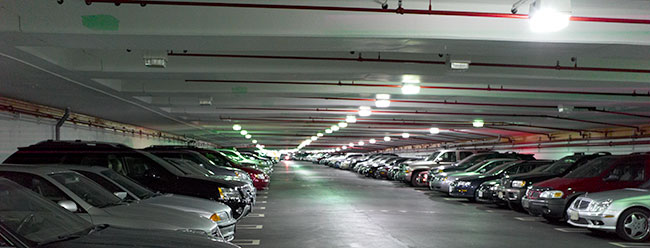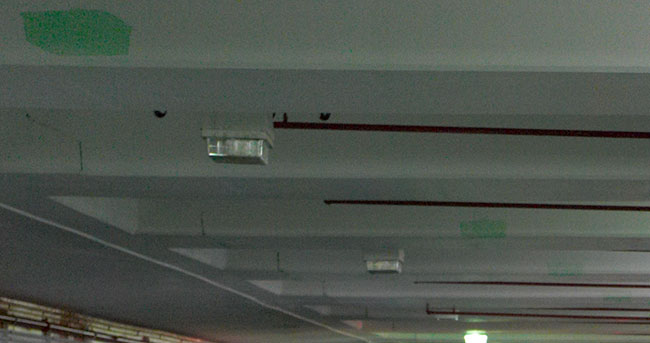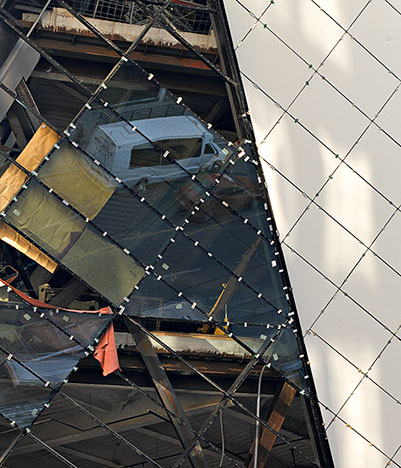Corporations can be just like people. They screw up from time to time. Some realize their mistakes more quickly than others, and some do the right thing to correct their mistakes, while others flounder.
In the case of theLeica M8the company shipped a flawed product, but then responded to the issue rather quickly. They then confused people with their initial responses. But in the end sorted it out – sort of.
Here’s my take on what happened, shortened and simplified somewhat because the full business details are likely only known to a few company insiders, and the technical minutia aren’t really relevant to the story.
_____________________________________________________
Once Upon a Time
The foundations of Leica’s reputation are in the M series cameras and in their lenses. For 50 years M cameras have been regarded as some of the finest photographic instruments available, both in terms of quality of materials and construction as well as appropriateness for certain types of photography. Leica’s lenses are simply unparalleled, both in terms of image quality, and, unfortunately, price. Quality simply doesn’t come cheap.
But the SLR revolution of the 1980’s onwards and then the digital revolution of the early 2000’s had increasingly turned Leica into a purveyor of boutique and collector’s products. Though the digital module for the R8 and R9 SLR cameras had much to recommend it in terms of image quality, these cameras were never mainstream, lacked autofocus, and were never at the core of the company’s mystique andraison d’etre.
In the early 2000’s the M series looked like its days were drawing to a close because Leica had announced that due to the very narrow distance between the rear of the lenses and the film / sensor plane, it would be impossible to produce a digital M. The angle of peripheral light rays would be too acute.
But, technology marches on and along with the engineers at Kodak a new chip with specially designed microlenses over each sensor element solved this problem. Additional solutions were needed though, and these involved the necessity for a very thin sensor cover glass, with little in the way of IR filtering and no anti-moire "blur" filter.
Leica knew going in that to be able to produce a digital M there would be compromises. The absence of a blur filter would be a plus for most photographers. Yes, there might be some occasional moire (easily dealt with in post processing if needed), but offering a real advantage in resolution, and taking full advantage of Leica’s superb lenses.
The real problem was the additional infrared sensitivity that the camera’s design necessitated. For reasons which can be read elsewhere if you want the gory technical details, it simply wasn’t possible to do full IR filtering with the sensor’s necessarily thin cover glass. Digital sensors are far more sensitive to infrared than is the human eye, and most cameras use varying degrees of sensor-covering IR blocking filters to deal with it.
The problem that this generated became apparent to reviewers and early customers when the camera started shipping in early November, 2006. What was immediately seen was that this extended IR sensitivity was causing problems. At first it wasn’t clear what was going on, but within a week or so we understood that certain dark (mostly black) fabrics and other materials were taking on a magenta cast.
Other problems were seen as well, and we’ll get to those in a minute, but the so-called magenta cast is the core issue.
As I see it, it is inconceivable that Leica’s engineers and its alpha and beta testers did not see and were not aware of this problem. Early external testers (like me) missed it at first. One has to shoot certain types of subjects under certain light for it to be obvious. And for the type of shooting that most people do with an M Leica – documentary – whether someone’s jacket or hat was a slightly different shade than it really was isn’t readily apparent after the fact. Also, shooting a standard target like a Macbeth chart doesn’t display the problem.
But during the months of pre-production testing surelysomeoneworking with or for Leica must have noticed this issue. Whether they did or not lies at the core of Leica’s current situation. Regardless, the company ended up shipping the camera with this problem and it rose up and bit them. Now we come to the solution and its consequences, as well as the silver lining.
Leica M8 with Tri-Elmat @ 50mm. ISO 320
_____________________________________________________
The Solution
We need to first look at a few other problems which the early M8 production cameras had. My guess is that about 1,500 camera in all were involved. These problems includedgreen ghosting, point source light smearing, and poor auto-white-balance. These have nothing to do with the magenta cast issue, and are part of the teething pains that new cameras sometimes have. Canon, Nikon and others have all experienced comparable new camera issues.
As part of their overall launch problem solution Leica has offered to take back to the factory subject cameras for the correction of these issues. But it needs to be understood that the factory recall is not part of the IR solution, but rather to fix these other problems. The magenta cast issue is only solved completely through the use of special infrared cut filters that fit over the lens. The company is now offering two free filters to owners when they register their M8, and additional filters will be available through dealers.
Now, whether this is a solution that appeals is a personal one. Some people always shoot with a UV filter on their lenses for protection, in which case a filter which offers UV + IR blocking will be no big deal. But there are many photographers who hate having to use filters, believing that they can cause image degradation, especially increasing the possibility for flare, both the obvious type and the more subtle contrast veiling form.
As this launch debacle recedes Leica will have to face the consequences of their design and market launch decisions. And photographers will have to decide if they mind having filters on their lenses or not. Those that don’t mind, and who would be otherwise disposed to purchase an M8, will do so. Those that do mind will decide against the purchase. It’s as simple as that. The real issue though is the business decision that Leica made to initially ship the camera to customers while almost certainly knowing that the cameras could only provide appropriate colour rendition if used with an IR lens filter. This will prove to have been a flawed decision that likely will cost Leica a great deal of money, and a loss of some valuable customer credibility. Nothing that can’t be regained eventually, but still an issue to contend with.
So, the first 1,500 or so camera purchasers will send their cameras back to have the other problems addressed, and anyone buying an M8 after early December, 2006 will get a camera without the green ghost and streaking issues. Apparently the auto-white balance issue will be addressed in a downloadable firmware upgrade. (See thePostscriptat the bottom of this page for an example of the Green Ghosting issue).
_____________________________________________________
The Profile Approach
Profiles can not fix the magenta cast problem. But, there is a profiling solution of sorts that will be found to be of value.Jamie Robertshas done the Leica community a real service by creating profiles which do a remarkable job of reducing the magenta cast. They can currently be downloadedhere, and you can stay up to date on future developments in this area on theLeica Camera User Forum.
The profiles are important, because Leica will not have IR lens filters available until January 2007. Many current users have thousands of frames already shot which they want to be able to correct, may shoot thousands of additional frames between now and January, and there will be those that want to continue to shoot with the M8 without filters even after they become available.
I have found that these profiles, while not doing a technically perfect job, are very effective, and I plan on using them alternately with IR filters as the situation dictates. I also quite like the palette that they create. It reminds me ofAgfachrome.
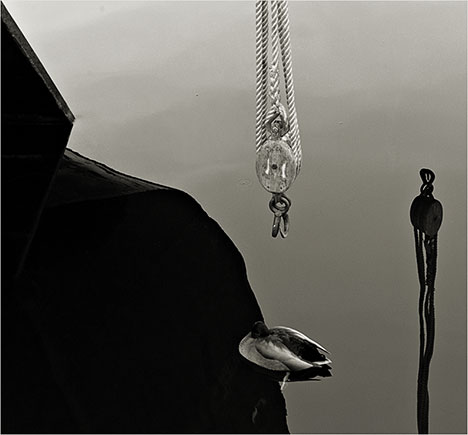
Duck Lift – Toronto. November, 2006
Leica M8 with Tri-Elmar @ 50mm. ISO 320
_____________________________________________________
The Silver Lining
I don’t wish to appear a Pollyanna, but there is a silver lining (pun intended) to all this. The M8’s high IR sensitivity is, of course, a plus for anyone wanting to shoot in the infrared. I wrotea short pieceon this, but with the caveat that it wasn’t suitable for hand-held shooting. Still, an IR sensitive camera without the need for modification will appeal to some.
More interestingly, because of its high IR sensitivity the M8 turns out to be an incredible B&W camera. This was first written about bySean ReidofReid Reviews. Whereas with digital cameras that have IR cut filters most dark subject matter is rendered as roughly a single luminance value, with the M8 there are beautiful subtle tonality to be seen in very dark areas. This is because though our eyes can’t make out the differentiation there can be many tonal shades within seemingly similar dark subjects when recorded in the infrared. When shot with an M8 and converted to B&W appropriately these can add a tonal depth and richness to an image which is quite remarkable. (Incidentally –Adobe Lightroomis excellent for grayscale conversion with M8 images. Lightroom can’t use Jamie’s profiles, but then these aren’t needed for monochrome work).
It has been pointed out that one of the finest B&W portrait films wasIlford Delta 400, a film with extended infrared sensitivity. Could the M8 be what B&W shooters have been looking for in a digital camera? I think so! Sean has also conjectured that those objects with high IR content may in fact be recorded at a slightly different point of focus, adding a very subtle "glow" in grayscale, which while hard to describe, can be quite striking in appearance.
Frankly, since M Leicas excel as documentary and street shooting cameras, and the vast majority of this type of work is done in B&W, for many users of the M8 the magenta cast issue and the need for special profiles and / or lens filters will be academic. The M8, as is, does a superlative job as a B&W camera, and when combined with a monochrome conversion utility such as found inApertureorLightroom, or a Photoshop plug-in such asConverttoB&WPro, it surpasses any previous M series film-based camera both in terms of tonal rendition and low light capability.
_____________________________________________________
In The End
In the end, though the M8’s launch was flawed those who want a digital M Leica will buy one and will enjoy what the camera has to offer. A few malcontents will continue to snipe from the weeds, as seems to be the case online with every camera brand.
The M8 is not for everyone. It never was intended to be. If the company had dealt with the extended IR sensitivity issue by explaining it prior to launch and by offering filters to purchasers up-front, the other problems discovered after launch, which necessitated an early recall, would have been soon forgotten. But because Leica has a historical profile for producing some of the finest photographic instruments, when they stumble it’s inevitably news. (How many years did it take for them to live down the wretched M5?)
Leica will survive. Maybe with its legendary reputation a bit tattered for a while, but nothing that a bit of time won’t cure.
December, 2006
_____________________________________________________
Postscript
The Green Ghosts
There has been much talk about the green ghost problem, but little evidence. Below is an example which clearly shows the problem.
The frames below were taken in an underground parking garage lit by sodium vapor lamps. In the Leica M8 frame there are very clear green ghosts on the left side of frame, of the bright light fixtures on the other side of the frame. These can be seen more clearly in the 100% crop.
